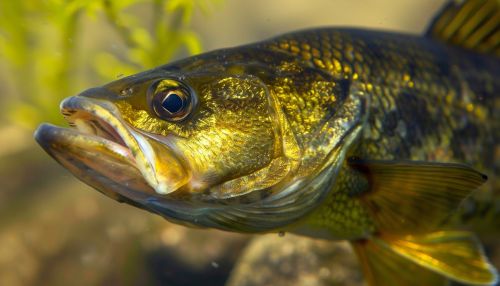Walleye
Biology and Description
The Walleye (Sander vitreus) is a species of freshwater fish native to North America. It is a member of the perch family, Percidae. The walleye is known for its olive and gold coloring, and its reflective eyes which are an adaptation for feeding in low light conditions. The walleye is a popular sport fish, and it is also commercially fished in many areas where it is native.


The walleye can grow up to 80 cm (31 in) in length and can weigh as much as 9 kg (20 lb). It has a cylindrical body shape, which is typical for fish that live in flowing water. The body is covered with rough scales, and the coloration varies from olive to gold, with darker markings on the back and sides.
The walleye has a large mouth with sharp teeth, which it uses to catch and hold onto its prey. The eyes are large and reflective, which allows the fish to see well in low light conditions. This adaptation is particularly useful in the murky waters where the walleye often lives.
Distribution and Habitat
The walleye is native to North America, where it is found in the Great Lakes region and the Mississippi River basin. It has also been introduced to other areas, including parts of Canada, the western United States, and parts of Europe and Asia.
The walleye prefers cool, clear waters with a rocky or sandy bottom. It is typically found in deep lakes and rivers, although it can also be found in shallower waters. The walleye is a bottom-dwelling fish, and it often hides among rocks or vegetation during the day.
Diet
The diet of the walleye consists mainly of smaller fish, although it will also eat insects, crustaceans, and other small aquatic animals. The walleye is a predatory fish, and it uses its sharp teeth and strong jaws to catch and hold onto its prey.
The walleye is known for its aggressive feeding behavior. It typically feeds at night, using its reflective eyes to locate prey in low light conditions. The walleye will often ambush its prey, hiding among rocks or vegetation and then striking quickly when a potential meal swims by.
Reproduction
The walleye is a broadcast spawner, which means that the female releases her eggs into the water, where they are fertilized by the male. The eggs are then left to develop on their own, without any further care from the parents.
The spawning season for the walleye typically occurs in the spring, when the water temperature is between 4 and 10 degrees Celsius (39 and 50 degrees Fahrenheit). The female walleye can produce up to 500,000 eggs per season, although the survival rate for these eggs is typically quite low.
Conservation Status
The walleye is not currently considered to be at risk of extinction, although populations in some areas have declined due to overfishing, habitat loss, and pollution. Conservation efforts for the walleye include regulations on fishing, habitat restoration, and the stocking of lakes and rivers with young walleye.
